Try Amazon Audible Premium Plus and Get Up to Two Free Audiobooks

Amazon Audible Gift Memberships
 P-47 Thunderbolt: Aviation Darwinism
Chapter Seven:
As 1944 dawned over the European Theater of Operations, major changes
were about to be made in the leadership and tactics of the
American Air Forces. General Tooey Spaatz would serve under
Eisenhower commanding the USSAFE. On January 6, Gen. Jimmy Doolittle
formally relieved Ira Eaker as commander of the 8th Air Force. Doolittle
allowed Gen. William Kepner to turn the 8ths escort fighters loose to hunt
down and destroy the Luftwaffe wherever they could be found. This is
worth noting, because no other order did more to eliminate the Luftwaffe
as a viable threat than this. The introduction of "phased-escort" tactics
did much to reduce the work load on the still too few long legged escorts
such as the P-38 Lightnings and the P-51 Mustangs. Flight routing of the
fighter escorts was planned to maximize endurance and allowed the shorter
ranging P-47s to fly deeper into enemy territory. Such routing also permitted
the long range escorts to remain longer over the target area. More importantly,
phased-escort allowed fighter groups to be relieved, which in turn allowed them
to head down to the deck and attack Luftwaffe airfields. It was not uncommon
for large groups of Mustangs to attack anything and everything in sight from
the heart of Germany all the way back to the coast of France. Suddenly,
no German airfield was safe from ambush. No Luftwaffe pilot could feel safe in
the air or even on the ground. No railroad or autobahn was safe from swift and
unexpected assault from the sky.
Beginning in hours of darkness on February 19-20, the 8th and 9th Air Forces
along with the RAF began operation Argument. Also known as
Big Week, this Allied air assault began with a heavy raid by
the RAF on Leipzig. Before the fires were even brought under
control, heavy bombers of the 8th pounded Leipzig again, along
with Gotha and Brunswick. In theory, these attacks were aimed
at Germany's war production plants and factories. In reality,
these missions were primarily designed to draw the Luftwaffe
into combat with the goal of grinding down their pilot manpower.
Argument was successful in inflicting severe losses to the Luftwaffe's
trained pilot corps. Ironically, actual German fighter production
was increasing. Nonetheless, planes without pilots are still
quite useless.
The pressure was kept up through March into April. Luftwaffe
pilot losses were becoming critical. All the while, the emphasis
was beginning to shift towards the destruction of German
transportation assets in preparation for the expected
invasion of France. The 9th Air Force was pounding coastal
defenses from Calais to Cherbourg. Bridges and marshalling
yards were being hammered on a daily basis by medium bombers.
With each day it was becoming more difficult to move equipment
from point to point in France. Simply driving down a roadway
presented a high risk of being strafed by roaming Allied fighters.
Things were growing more desperate for the Luftwaffe in France.
Allied bombers and fighters were also concentrating on putting
every German aerodrome within range of Caen out of action.
The Luftwaffe was forced to disburse aircraft away from airfields,
even positioning fighters to use highways as runways. Things were
rapidly becoming untenable for the German Air Force. By mid May
of 1944, the Luftwaffe had ceased to be a factor over France.
The Allies now had complete and unchallenged air superiority
over the whole of western Europe, with total air supremacy
over France.
P-47 Thunderbolt: Aviation Darwinism
Chapter Seven:
As 1944 dawned over the European Theater of Operations, major changes
were about to be made in the leadership and tactics of the
American Air Forces. General Tooey Spaatz would serve under
Eisenhower commanding the USSAFE. On January 6, Gen. Jimmy Doolittle
formally relieved Ira Eaker as commander of the 8th Air Force. Doolittle
allowed Gen. William Kepner to turn the 8ths escort fighters loose to hunt
down and destroy the Luftwaffe wherever they could be found. This is
worth noting, because no other order did more to eliminate the Luftwaffe
as a viable threat than this. The introduction of "phased-escort" tactics
did much to reduce the work load on the still too few long legged escorts
such as the P-38 Lightnings and the P-51 Mustangs. Flight routing of the
fighter escorts was planned to maximize endurance and allowed the shorter
ranging P-47s to fly deeper into enemy territory. Such routing also permitted
the long range escorts to remain longer over the target area. More importantly,
phased-escort allowed fighter groups to be relieved, which in turn allowed them
to head down to the deck and attack Luftwaffe airfields. It was not uncommon
for large groups of Mustangs to attack anything and everything in sight from
the heart of Germany all the way back to the coast of France. Suddenly,
no German airfield was safe from ambush. No Luftwaffe pilot could feel safe in
the air or even on the ground. No railroad or autobahn was safe from swift and
unexpected assault from the sky.
Beginning in hours of darkness on February 19-20, the 8th and 9th Air Forces
along with the RAF began operation Argument. Also known as
Big Week, this Allied air assault began with a heavy raid by
the RAF on Leipzig. Before the fires were even brought under
control, heavy bombers of the 8th pounded Leipzig again, along
with Gotha and Brunswick. In theory, these attacks were aimed
at Germany's war production plants and factories. In reality,
these missions were primarily designed to draw the Luftwaffe
into combat with the goal of grinding down their pilot manpower.
Argument was successful in inflicting severe losses to the Luftwaffe's
trained pilot corps. Ironically, actual German fighter production
was increasing. Nonetheless, planes without pilots are still
quite useless.
The pressure was kept up through March into April. Luftwaffe
pilot losses were becoming critical. All the while, the emphasis
was beginning to shift towards the destruction of German
transportation assets in preparation for the expected
invasion of France. The 9th Air Force was pounding coastal
defenses from Calais to Cherbourg. Bridges and marshalling
yards were being hammered on a daily basis by medium bombers.
With each day it was becoming more difficult to move equipment
from point to point in France. Simply driving down a roadway
presented a high risk of being strafed by roaming Allied fighters.
Things were growing more desperate for the Luftwaffe in France.
Allied bombers and fighters were also concentrating on putting
every German aerodrome within range of Caen out of action.
The Luftwaffe was forced to disburse aircraft away from airfields,
even positioning fighters to use highways as runways. Things were
rapidly becoming untenable for the German Air Force. By mid May
of 1944, the Luftwaffe had ceased to be a factor over France.
The Allies now had complete and unchallenged air superiority
over the whole of western Europe, with total air supremacy
over France.
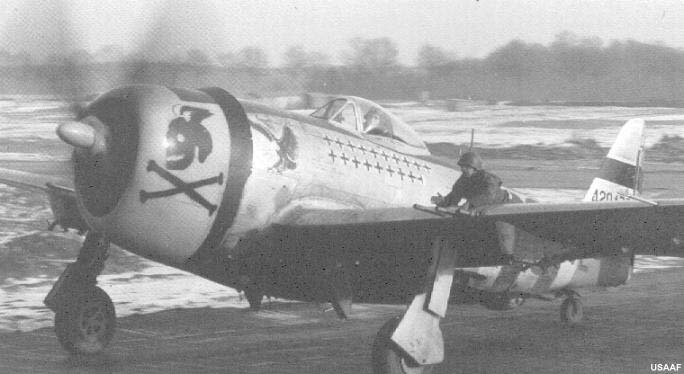 Many of the 9th Air Force pilots became celebrated aces despite being
generally assigned to tactical ground attack missions. Maj. Glenn Eagleston
of the 354th Fighter Group ran up the highest score in the 9th. With no
less than 18.5 confirmed victories, it is reasonable to speculate how high
his total may have been had he flown with the 8th Air Force instead. Here
Eagleston taxis in from a mission with the aid of a ground crewman giving
taxi directions. It not possible to see over the Thunderbolts long nose
while on the ground. Without a taxi director on the wing, the fighter would
have to be taxied by zig-zagging from side to side while peering out of
the front quarters of the canopy. This is a P-47D-30-RE. The photo was
taken in December of 1944. Note that the invasion stripes applied in June
have not yet been removed.
Many of the 9th Air Force pilots became celebrated aces despite being
generally assigned to tactical ground attack missions. Maj. Glenn Eagleston
of the 354th Fighter Group ran up the highest score in the 9th. With no
less than 18.5 confirmed victories, it is reasonable to speculate how high
his total may have been had he flown with the 8th Air Force instead. Here
Eagleston taxis in from a mission with the aid of a ground crewman giving
taxi directions. It not possible to see over the Thunderbolts long nose
while on the ground. Without a taxi director on the wing, the fighter would
have to be taxied by zig-zagging from side to side while peering out of
the front quarters of the canopy. This is a P-47D-30-RE. The photo was
taken in December of 1944. Note that the invasion stripes applied in June
have not yet been removed.
Adding to the already cascading woes of the German war machine was the effort
being mounted to destroy Germany's ability to produce aviation
and motor vehicle fuel. Refineries and storage facilities
were getting worked over by the heavy bombers of the 8th and
15th Air Forces. One sure-fire method of keeping the Luftwaffe
on the ground everywhere was to eliminate its sources of fuel.
At long last, fuel had become a high priority target for the
Allied bombers.
Along with the medium bombers of the 9th Air Force, the P-47, P-51 and P-38
were now being used with great effect in the role of tactical fighter-bomber.
Of the three fighter types, the P-47 would prove to be the most widely used in
this role and the big Thunderbolt would rival the RAF's Hawker Typhoon for the
title of best air to ground fighter in the ETO. Many (including this writer)
have since concluded that the Thunderbolt was superior to the Typhoon due to
the greater resistance of its radial engine to battle damage. The big R-2800
did not have a liquid cooling system that could easily be punctured by enemy
ground fire as did the Typhoon. Moreover, the Hawker fighter was powered by
the infamously unreliable Napier Sabre H-24 engine. The Pratt & Whitney engine
was by contrast, utterly dependable.
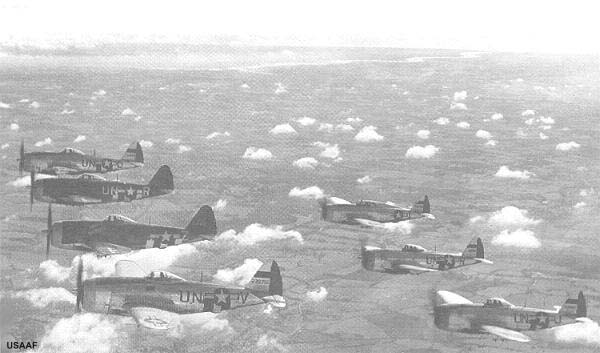 Here we see a portion of the 63rd Fighter Squadron (56th FG) flying in
formation. In this group of P-47s we can see several different sub-models.
These include several P-47D-25-RE and at least one P-47D-28-RE. The single
"razor back" in the trailing section is probably a P-47D-23-RA. This photo
was likely taken in July of 1944.
Here we see a portion of the 63rd Fighter Squadron (56th FG) flying in
formation. In this group of P-47s we can see several different sub-models.
These include several P-47D-25-RE and at least one P-47D-28-RE. The single
"razor back" in the trailing section is probably a P-47D-23-RA. This photo
was likely taken in July of 1944.
With the invasion of France (Operation Overlord) on June 6, 1944, the primary
mission of Allied Air Forces was now focused on supporting the Allied army
forces in Normandy. The Luftwaffe was all but eliminated from the equation.
Only two German fighters had been able to reach the beaches on D-Day. 26 other
German fighters and bombers were destroyed attempting to reach the landing
area. None even got within sight of the beaches.
The Thunderbolt had already displayed its ability to use its eight .50 caliber
machine guns very effectively against ground targets. Now, it would be employed
as a fighter-bomber, delivering up to 2,000 lbs of bombs and rockets with great
efficiency and accuracy against a wide range of German targets.
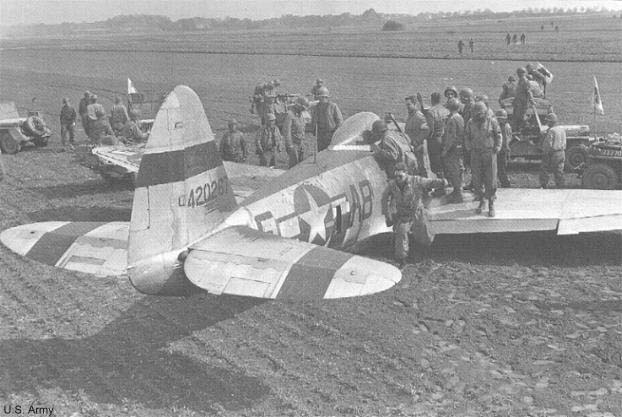 This Thunderbolt suffered disabling engine damage from ground fire in April of 1945.
The pilot elected to execute a wheels up landing in a soft field. Damage
to the fighter is minimal and it would be repaired and back in service
in very short order. Certainly, such a spectacular landing will draw a
crowd of onlookers. In this case American GIs swarm around the Thunderbolt
to get a close look at what they had seen pounding the Germans all across
western Europe.
This Thunderbolt suffered disabling engine damage from ground fire in April of 1945.
The pilot elected to execute a wheels up landing in a soft field. Damage
to the fighter is minimal and it would be repaired and back in service
in very short order. Certainly, such a spectacular landing will draw a
crowd of onlookers. In this case American GIs swarm around the Thunderbolt
to get a close look at what they had seen pounding the Germans all across
western Europe.
Most missions were flown with a specific target designated. However,
increasingly, the P-47s were being used to attack targets of opportunity.
No German vehicle dared move in daylight without the great risk that roving
groups of P-47s would spot the movement and swoop down with devastating results.
The complete lack of Luftwaffe support contributed to falling morale among
German troops. They knew with certainty that if they heard or saw any aircraft,
it belonged to the enemy. The breakout of the American 1st and 3rd Armies into
the interior of France was partially a result of overwhelming air attacks by
the American 8th and 9th Air Forces. Many thousands of sorties were flown by
P-47s in support of Operation Cobra, which sprung Gen. Patton's 3rd Army loose
to envelope the major portion of German forces in France by closing their
escape route between Argentan and Falaise.
The war in Italy was somewhat different than that in France. Italy is largely a
mountainous country, and the progress of ground forces was very much slowed
by expert use of this terrain by the Germans. P-47s served with great
distinction in Italy. Flying with the 12th and 15th Air Forces, the Jugs
performed every type of mission imaginable. Eventually, just as in the ETO,
all 15th Air Force P-47s were transferred to the 12th Tactical Air Force,
being replaced by P-51s. As in the ETO, P-47s still flew escort for medium
bombers. However, their primary mission had become that of tactical
fighter-bomber. One of the lesser known units serving in the war in Italy
was the Brazilian squadron operating P-47s flying with the USAAF's 350th FG.
The P-47 performed with the same outstanding effectiveness in the MTO as they
did with the 8th and 9th Air Forces in the ETO.
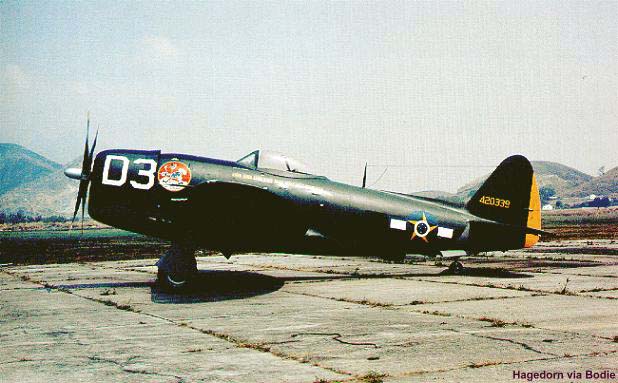 This P-47D-30-RE served with Forca Aerea Brasileira in Italy. This Brazilian
unit was attached to the 350th FG of the 12th Air Force. Note the dorsal fillet
at the base of the rudder leading edge. This partially restored the flat plate
side area of the bubble canopy P-47s. A larger and more effective fillet would
be installed on the long range P-47N.
This P-47D-30-RE served with Forca Aerea Brasileira in Italy. This Brazilian
unit was attached to the 350th FG of the 12th Air Force. Note the dorsal fillet
at the base of the rudder leading edge. This partially restored the flat plate
side area of the bubble canopy P-47s. A larger and more effective fillet would
be installed on the long range P-47N.
The principal model of the Thunderbolt in use at the time was the P-47D. These
included several different sub-models of the D. It should be mentioned that
there were no less than 21 individual sub-models of the P-47D alone. These
included the P-47D-25-RE that began arriving in the ETO in May of 1944. The -25
was considerably different in appearance as compared to the previously
manufactured models. The fuselage had been cut down behind the cockpit and a
new bubble type of canopy replaced the old framed glass that had remained
essentially unchanged since the YP-43. The new canopy presented the pilots with
an unparalleled view outside of the aircraft. It did, however, actually cause
an increase in drag, which reduced the maximum speed of the
fighter by about 6 mph. On the positive side, the new Thunderbolt
arrived with 100 gallons greater internal fuel capacity. This brought the
total internal fuel load to 370 gallons. Finally, the P-47 had the range to
fly as far as Berlin. Ironically, this new P-47 arrived when most Thunderbolts
were about to be transferred to the 9th Air Force and used as tactical
fighter-bombers. In point of fact, by 1945 every 8th Air Force Fighter Group
was flying the P-51 Mustang with one notable exception. The 56th were allowed
to keep their much loved Thunderbolts.
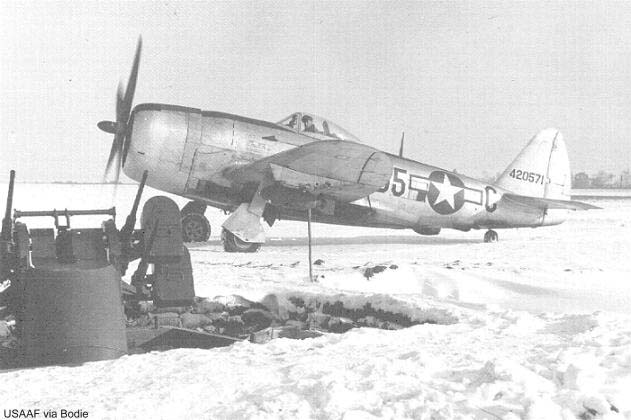 This P-47D-30-RE warms up on a snow covered taxiway prior to taking off
on a ground attack mission during the Battle of the Bulge. Based only a
short distance from the front lines, these fighters would frequently fly
as many as four combat missions a day. Especially during the unexpected
German attack through the lightly defended Ardennes forest. This fighter
of the 356th Fighter Squadron will soon drop its 500 lb. bombs on luckless
Wehrmacht troops trapped in a pocket of their own making. Note the quad
.50 caliber machine gun anti-aircraft mount in the foreground. These airfields
were close enough to the front as to expect Luftwaffe raiders at almost
any time. Fortunately, the decimated Luftwaffe could rarely break through the
Allied fighters. Nonetheless, forward airfields such as this were ready
and alert for just that possibility.
This P-47D-30-RE warms up on a snow covered taxiway prior to taking off
on a ground attack mission during the Battle of the Bulge. Based only a
short distance from the front lines, these fighters would frequently fly
as many as four combat missions a day. Especially during the unexpected
German attack through the lightly defended Ardennes forest. This fighter
of the 356th Fighter Squadron will soon drop its 500 lb. bombs on luckless
Wehrmacht troops trapped in a pocket of their own making. Note the quad
.50 caliber machine gun anti-aircraft mount in the foreground. These airfields
were close enough to the front as to expect Luftwaffe raiders at almost
any time. Fortunately, the decimated Luftwaffe could rarely break through the
Allied fighters. Nonetheless, forward airfields such as this were ready
and alert for just that possibility.
Many of the Fighter Groups flying the P-47 in June of '44 were
still flying some of the older "razor back" models with the framed canopy.
These included the ultimate "razor back", the P-47D-23-RA. This Evansville
built fighter was equipped with the latest Curtiss Electric paddle blade
propeller. Of all the D models, this one was the fastest and best climbing.
As the war in the ETO progressed, the P-47 would pound the German army without
let-up or mercy. Soon after the invasion began, 9th Air Force Fighter Groups
were transferred from Britain to newly captured or prepared forward airfields
not far from the front lines. This greatly shortened the response time required
between receiving a call for air support and actually being able to deliver the
support. In many instances, the Thunderbolts were based barely 5 minutes flying
time from the battle area. By December of 1944, all tactical aircraft were
based in France or Belgium.
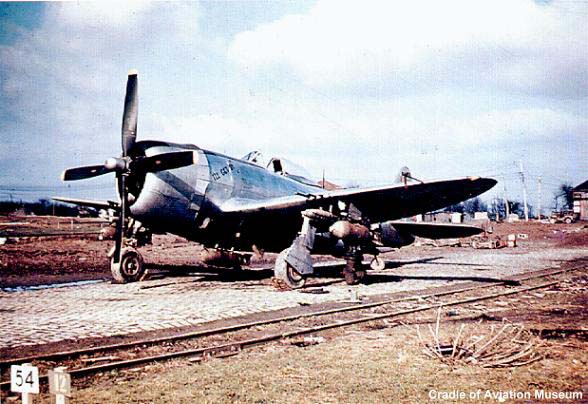 This P-47D-27-RE of the 404th FG sits awaiting a mission. It has been fully armed
with three 500 lb. bombs and four 5 inch rockets. Basing fighter-bombers
close to the front greatly shortened reaction time and tremendously enhanced
ground attack coordination.
This P-47D-27-RE of the 404th FG sits awaiting a mission. It has been fully armed
with three 500 lb. bombs and four 5 inch rockets. Basing fighter-bombers
close to the front greatly shortened reaction time and tremendously enhanced
ground attack coordination.
With the coming of June '44, something besides the invasion of France was on the
minds of the people of Britain. On night of June 12-13 the Germans launched the
first of over 6,700 V-1 flying bombs. This was the first of Hitler's Vengeance
Weapons. They created near panic in Britain. While not exceptionally effective
weapons in a strategic sense, they were effective at pulling RAF resources away
from prosecuting the war to defending the airspace over Britain. Moreover, the
V-1 (and later V-2 ballistic missile) did more to hurt British home front morale
than did the air Blitz of 1940-41. The British government turned to the United
States for assistance.
Eventually, Republic was informed of the British request for a high speed
interceptor specifically to chase down and destroy the V-1. Remarkably, Republic
already had a solution in hand. This would take the form of the the incredibly
fast P-47M-1-RE. Let's go back more than a year and see how Republic came to
have this speedster in their vest pocket when the British inspired inquiry arrived.
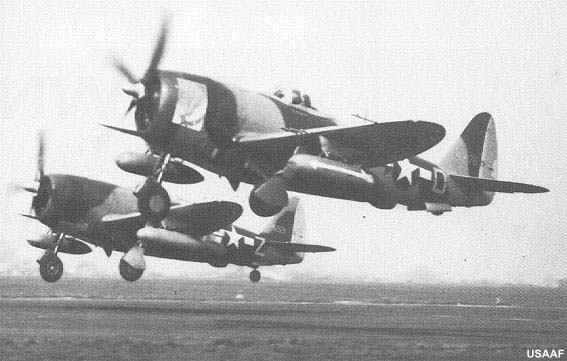 These P-47M-1-RE fighters belong to the 56th Fighter Group. These are fitted
with wing pylons for external stores. P-47Ms were originally produced
without pylons, which were deemed unnecessary for chasing V-1 flying bombs.
Once free of that duty, pylons were quickly added. The nearest fighter
is that belonging to Lt. Col. Pete Dade.
These P-47M-1-RE fighters belong to the 56th Fighter Group. These are fitted
with wing pylons for external stores. P-47Ms were originally produced
without pylons, which were deemed unnecessary for chasing V-1 flying bombs.
Once free of that duty, pylons were quickly added. The nearest fighter
is that belonging to Lt. Col. Pete Dade.
The XP-47M was, essentially, developed collaterally with the XP-47J. The
J was fitted with a high output version of the P&W R-2800. Specifically,
the R-2800-57. This engine made 2,800 hp @ 2,800 rpm at 35,000 feet.
This is in War Emergency Power. The aircraft actually attained 507 mph at
an altitude of 34,300 feet. 2,800 hp is 133% of rated power. At military power
(100%), the XP-47J could sustain 470 mph. 435 mph was attained at 81% of
it's rated power (1,700 hp). All performance figures were obtained at 34,300
feet. The J model was an especially good climbing fighter too. It had a
climb rate at sea level of 4,900 fpm. At 20,000 feet, it was still rocketing
up at 4,400 fpm, and got there in 4 minutes, 15 seconds. Time to 30,000
feet was only 6 minutes, 45 seconds. Now that's an interceptor! Yet it had
a usable range of 1,075 miles. Rather impressive performance. Nor was this
a stripped down hotrod. It was fully armed and carried ballast in the
wings equal to 267 rds per gun. The aircraft was flown to a height of 46,500
feet and was capable of a bit more.
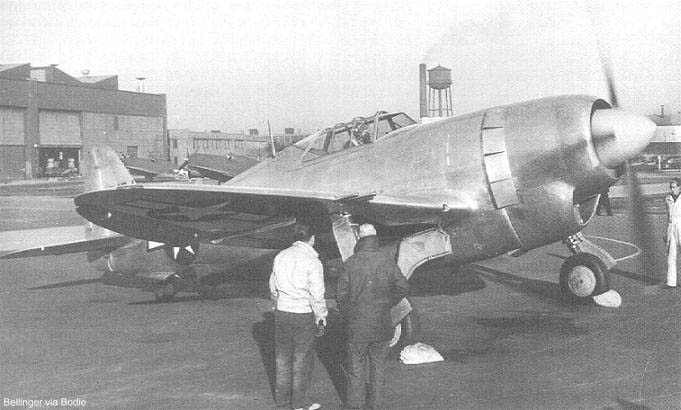 Chief test pilot Lowery Brabham warms up the XP-47J prior to an early flight in November of 1943.
Note the exceptionally tight cowling installation and spinner. This
layout worked well, but was not adopted for production P-47s due to increased
cost and complexity. However, a similar cowling was incorporated into the
XP-72 little more than a year later.
Chief test pilot Lowery Brabham warms up the XP-47J prior to an early flight in November of 1943.
Note the exceptionally tight cowling installation and spinner. This
layout worked well, but was not adopted for production P-47s due to increased
cost and complexity. However, a similar cowling was incorporated into the
XP-72 little more than a year later.
Originally designed to defeat the FW-190 series fighters, the XP-47J
certainly would have exceeded this requirement. In point of fact, with its
critical Mach of .83, it had the potential to chase down Me-262's by utilizing
a shallow dive, taking advantage of its superior service ceiling.
Despite this incredible performance, the XP-47J was really nothing more than
a technology demonstrator. Meanwhile, the R-2800 C series was installed in
another, more ordinary Thunderbolt P-47C. The purpose was to trade a little
performance for simplicity of manufacture. The idea being that a minimum
of changes were required to the current aircraft for the C series engine.
The aircraft that resulted was designated the XP-47M. Not "officially sanctioned",
the XP-47M was an "in-house" development program. The "M" was painted in
chromate yellow to distinguish it from the run of the mill C and D models.
Likely, this overly bright paint scheme was selected to indicate it's test status
in order to prevent over-zealous P-47 and F6F pilots from making mock attacks,
as was the standard rule of the day over wartime Long Island.
Right out of the starting gate, the XP-47M the horse to beat in terms of speed.
The XP-47M proved to be nearly as fast as the XP-47J. 488 mph was obtained
on at least one flight. The official maximum speed is 470 mph. However,
over-boosting the engine could tweak another 15 to 20 mph out of the big fighter.
Some may find this next tidbit hard to swallow, however, the test documents still
exist.
During durability testing of the C series R-2800 by Republic, it was decided
to find out at what manifold pressure and carburetor temperature caused detonation.
The technicians at Republic ran the engine at extreme boost pressures that produced
3,600 hp! But wait, it gets even more amazing. They ran it at 3,600 hp for 250
hours, without any failure! This was with common 100 octane avgas. No special fuels
were used. Granted, the engines were largely used up, but survived without
a single component failure. Try this with Rolls Royce Merlin or Allison V-1710 and
see what happens.
As mid June of 1944 arrived, so did the first of Germany's Vengeance weapons.
Flying at speeds right around 400 mph., the V-1 was not easy to intercept prior to
flying over populated areas, where knocking it down could have a worse effect than
leaving it alone. Many of the RAF's latest fighters were thrown into intercepting
the "Buzz Bombs", preferably over the English Channel. Tempests, late Mark Spitfires and
even the jet powered (but not especially fast) Meteors were put to work intercepting
the deadly "Doodle Bugs".
Upon the USAAF being informed of the XP-47M, three YP-47M development aircraft were immediately ordered.
These were built using P-47D-27-RE fighters straight off the production line.
Having already logged hundreds of flights with the XP-47M, beginning in mid
1943, Republic had a big leg up in terms of development time. Actual production
P-47M fighters used the P-47D-30-RE as the basic airframe.
The production P-47M fighters did not reach operational status until after many of
the V-1 launch sites were over-run by Allied ground forces. Deployed to 3 squadrons
of the 56th Fighter Group, the new fighter likely did not chase very many flying bombs.
Inasmuch as most aviation historians claim that the P-47M was designed specifically
to intercept the V-1, it will come as a surprise to them to learn that the prototype
existed more than a year before the first V-1 was launched at Britain. Moreover, the
P-47D, deployed in large numbers, was certainly fast enough to overtake the V-1. It
was only coincidence that the XP-47M and the R-2800 C series engines were available
when the V-1's began falling on London.
The new M models also suffered a fair amount of teething troubles. The C series engines
suffered from high altitude ignition leaks and burned pistons.
The 56th kept many of their older D models until the new M had
its bugs corrected. Nonetheless, once sorted out, the P-47M
was the fastest propeller driven fighter to see combat service
in any Air Force in the ETO. Capable of speeds up to 475 mph,
the M was a true "hotrod".
As the German army was pushed closer to the border of their
homeland, newer sub-models of the P-47D found their way into
service. The P-47D-27-RE arrived with an up-rated engine of
2,430 hp. and Hamilton-Standard propeller. The P-47D-28-RA
was essentially the same aircraft, but used a Curtiss Electric
prop. Some of the next to last sub-model, the P-47D-30-RE,
incorporated a new dorsal fillet at the base of the rudder
assembly. Virtually all of the final D model, the P-47D-40-RA
had the fillet installed. The loss of side area due to the cutting down of
the fuselage (to accommodate the bubble canopy), reduced the
linear stability of the bubble topped Jugs. This could lead
to a loss of control if rudder deflection was too great at
low speeds. The fillet partially corrected this rudder force
over-balance condition. It would not be fully eliminated until
the final production model of the Thunderbolt. The P-47D-40-RA
was the first P-47 to have the new K-14 gunsight installed at
the factory. It was also the first Thunderbolt to carry the new
tail warning radar equipment.
As the war in the Europe came to end in early May of 1945, the
mighty P-47 Thunderbolt was to shoot down its last aerial adversary
on May 4th. The victim was one of the speedy Me 262 jet fighters.
By May 6th, only armed recon missions were being flown in the ETO.
Two days later, the war with Germany was officially at an end.
While peace had come to Europe, war was still raging on the other
side of the world. It was in the far reaches of the Pacific that
the latest, and possibly greatest model of the P-47 would hurl
itself at the Japanese. Too late to impact the war in Europe,
the P-47N would set a new standard for single engine long range
performance.
Go to Chapter Eight
Return to the Planes and Pilots of WWII
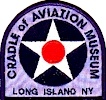 Return to the Cradle of Aviation Museum
Return to the Cradle of Aviation Museum

Unless otherwise indicated, all articles Copyright © Jordan Publishing Inc. 1998/1999/2000.
Reproduction for distribution, or posting to a public forum without express written
permission is a violation of applicable copyright law. The Cradle of Aviation
Museum
patch is the property of the Cradle of Aviation Museum.
Reproduction for distribution, or posting to a public forum without the written permission
of Jordan Publishing Inc. is prohibited.

 P-47 Thunderbolt: Aviation Darwinism
Chapter Seven:
P-47 Thunderbolt: Aviation Darwinism
Chapter Seven:

 P-47 Thunderbolt: Aviation Darwinism
Chapter Seven:
P-47 Thunderbolt: Aviation Darwinism
Chapter Seven:









